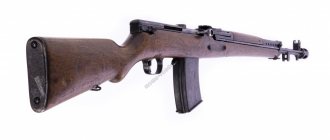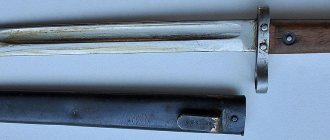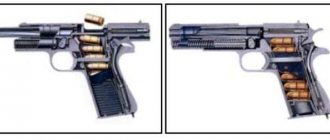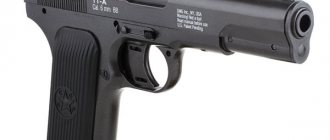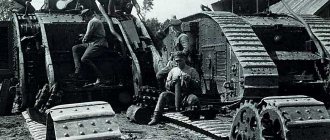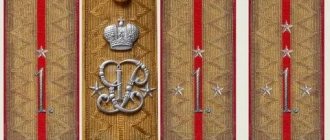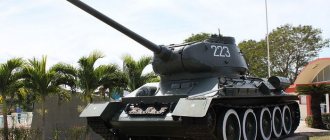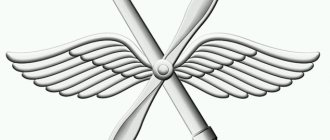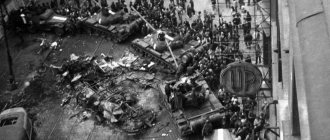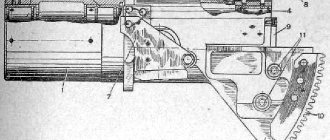Lapel badges-emblems of the military branches and services of the Red Army, model 1936
The system of insignia on the buttonholes of Red Army soldiers, first introduced by Order of the RVSR No. 322 of January 31, 1922, was subject to constant changes during 1922-23, and as a result turned out to be unnecessarily cumbersome and extremely difficult to understand even by the military personnel themselves. Moreover, there was no centralized production and supply of badges to troops, and therefore the units themselves were directly involved in the production of metal emblems.
To resolve the current situation, on June 20, 1924, Order No. 807 of the Revolutionary Military Council of the USSR was issued, which established, in particular, new badges for the specialties of military personnel, units and units - a total of 14 emblems. They were received by:
1. Military engineering inspection of the district, front, army; engineers of rifle corps and divisions; 2. Separate sapper companies, sapper battalions and fortress sapper companies; 3. Sapper squadrons and half-squadrons; 4. Pontoon battalions; 5. Electrical battalions; 6. Mine squads; 7. Automotive troops; 8. Camouflage troops; 9. Railway troops; 10. Commandant's offices of railway stations and piers; 11. Communications inspections of the Red Army, district, front, army; communications chiefs of corps and divisions; 12. Communication trains of the Red Army headquarters, regiments, battalions, companies and communications squadrons; 13. Radiotelegraph battalions and companies; 14. Postal pigeon stations.
The emblem drawings are taken from the collection “Illustrated description of uniforms and insignia of the Soviet Army (1918-1958)” compiled by O.V. Kharitonov (Leningrad, 1960).
The resolution of the Commission of the Deputy Chief of Supply of the Red Army, which prepared the Order, specified that specialty badges on buttonholes were only awarded to military personnel of the technical troops. For military personnel of the main branches of the military, who were assigned a certain color of instrument cloth, badges were not introduced.
The text of the order also mentioned the 15th emblem - for the personnel of the military sanitary department (a red metal equilateral cross). However, less than two months later, by Order of the Revolutionary Military Council of the USSR No. 1058 dated August 19, 1924, it was replaced by a new golden-colored sign in the form of a snake entwining a bowl.
Subsequently, a number of additional emblems were introduced. Among them, in particular, we can note the emblems for the following categories of military personnel:
— military chemical units and institutions of the Red Army (Order of the USSR Revolutionary Military Council No. 721 of December 2, 1926). - the commanding staff of the fire brigade of the Red Army, staffed by conscripts of the Red Army, as well as fire inspectors of the Red Army, who are in the reserve of the Red Army (Order of the Revolutionary Military Council of the USSR No. 152 of 08/10/1932). - military attaches, regardless of the service category assigned to them (Order of the USSR Revolutionary Military Council No. 220 of November 18, 1932, “Rules for wearing uniforms by military personnel of the Red Army”).
This entire system existed until March 1936.
The emblems discussed in this material for wearing on uniforms of ordinary, command and command personnel of the Red Army were introduced by order of the USSR NKO No. 33 dated March 10, 1936. At the same time, the previous normative act regulating the use of signs in the specialties of military personnel, units and units became invalid - Order of the Revolutionary Military Council of the USSR No. 807 of June 20, 1924
A total of 17 emblems were established, images of which are presented below. It is worth noting, however, that the illustration from the book does not show the original sign of the Railway Troops and VOSO (Military Communications Service), but a sign of the second type, established by Order of the NKO of the USSR No. 165 of 08/31/1936.
The names of the emblems are given in accordance with the text of the Charter of the Internal Service of the Red Army 1937 (UVS-37), published in 1938, and their detailed description is made by the author:
1 – ABT (armored vehicles) troops. Stylized image of the light wheeled-tracked tank BT-5. 2 – Military-technical composition of all military branches and services. A hammer placed crosswise over a French hammer, or an adjustable wrench. 3 – Air Force of the Red Army. A vertically positioned two-blade propeller superimposed on a pair of horizontal wings. 4 – Railway troops and VOSO. A red enamel five-pointed star superimposed on an anchor with wings and a crossed hammer and wrench. 5 – Artillery. Two crossed gun barrels. 6 – Auto parts and drivers of all military branches, except ABT troops. A front automobile axle with two wheels, a steering wheel and a steering column, as well as two vertically raised wings. 7 – Signal troops and signal units in other branches of the military. A pair of horizontally spread wings and three vertical lightning bolts with a red enamel five-pointed star superimposed on top of the composition. 8 – Engineer troops. Two crossed axes with curved handles. 9 – Military medical personnel of all branches of the military (golden color). The gold-colored medical emblem is a snake entwined around a bowl. 10 – Military veterinary personnel of all military branches (silver color). A mirror image of the above emblem in silver. 11 – Chemical troops and chemical units in other branches of the military. Two crossed gas cylinders with a gas mask applied vertically. 12 – Sapper units and sapper units in other branches of the military (in the original – “Sapper troops”). A shovel placed crosswise on a pickaxe. 13 – Bandmasters of all branches of the military. Stylized image of a lyre. 14 – Military-economic and administrative composition of all branches of the military. The emblem has a complex shape: a ring formed by half a car tire on the left and a gear on the right, on which three elements are superimposed - a compass with spread legs, a diagonally positioned adjustable wrench and a small profile helmet in the center. 15 – Military-legal composition of all branches of the military. A shield of English form, superimposed on two crossed swords with the points down. 16 – Pontoon units and pontoon units in other branches of the military. A stylized image of an anchor, under the eye of which there are two crossed axes. 17 – Electrical parts. A crossed ax and shovel superimposed on two horizontal zippers.
Initially, representatives of privates, junior command and command personnel of conscript service were instructed to apply emblems to their buttonholes using a stencil using yellow oil paint. The emblems stamped from copper were reserved only for the command, command and junior command staff of the long-term service of the Red Army, as well as cadets of military schools. Faced in practice with the impossibility of high-quality application of sufficiently miniature images on buttonholes, it was decided to abandon stenciled lapel insignia and extend the wearing of their metal analogues to all personnel of the Red Army. At the same time, the lack of production capacity and the gigantic volumes of new orders led to the fact that some military personnel continued to use the 1924-1932 insignia for some time, or did not wear them at all.
The orientation of the emblems on the buttonholes, that is, the use of each of them as left or right, was not regulated by the Order. In practice, the lapel badges of the armored forces in most cases were attached with turret guns from each other, the badges of military doctors - with the heads of snakes to each other, and the badges of military veterinarians - vice versa. In the photographs you can see not only exceptions to this unwritten rule, but even the simultaneous wearing of two identical emblems.
Buttonholes without emblems were worn by soldiers of infantry and cavalry units - they received special insignia only in July 1940 (Order of the USSR NKO No. 226 of July 26, 1940). This circumstance could be caused by echoes of the traditions of the imperial army, in which distinctive emblems were assigned to technical branches of the military.
For representatives of the military-political personnel of the Red Army (except for students of military schools, military faculties and academies - abbreviations of educational institutions were indicated on their buttonholes) no special emblems were also introduced, and they continued to wear “empty” buttonholes in the colors of the unit in which they served . Special signs for them were introduced by Order of the NGOs of the USSR No. 226 of July 26, 1940.
The signs described, with the exception of those intended for military veterinarians, were made of yellow metal and had a golden color. On the reverse side, a pair of mustaches were soldered to them for attachment to the buttonhole. On tunics, the emblems were worn in the far corner of the buttonholes (regardless of the presence of insignia), and on overcoats - in the upper part of the diamond-shaped buttonholes, above the insignia.
According to the Order of the NCO of the USSR No. 229 of December 17, 1936, representatives of the commanding staff of the military-technical, military-economic, administrative, military-legal, military-medical and military-veterinary services wore the emblems established for them, regardless of the type of troops where they served. The only exceptions were students of military schools, military faculties and academies.
The command, military-political, military-technical, military-legal commanders and rank and file of the ground and air forces of the Red Army wore buttonholes of the type of troops in which they served.
Command, military-political, military-technical, military-legal command staff of rear institutions and headquarters (up to and including district headquarters, directorates and departments) wore buttonholes of the type of troops in which they served before being appointed to a rear institution or headquarters.
Special units that were part of individual military units, such as regimental artillery, communications, etc. the buttonholes of these parts were worn.
At the initial period of the Great Patriotic War, emblems for camouflage purposes were covered with green paint of various shades in accordance with Order of the USSR NPO No. 253 of 08/01/1941 “On changing the uniform of the Red Army in wartime.”
Below are images of all twenty emblems (including two qualification marks) that were introduced for wear by Red Army personnel during 1936.
1 – Armored troops; 2 – Military-technical composition of all military branches and services; 3 – Air Force of the Red Army; 4 – Railway troops and VOSO (early emblem); 5 – Railway troops and VOSO (emblem of the second type); 6 – Artillery; 7 – Auto parts and drivers of all branches of the military, except for the armored forces; 8 – Signal troops and signal units in other branches of the military; 9 – Engineer troops; 10 – Military medical personnel of all military branches; 11 – Military veterinary personnel of all military branches; 12 – Chemical troops and chemical units in other branches of the military; 13 – Sapper units and sapper units in other branches of the military; 14 – Bandmasters of all branches of the military; 15 – Military-economic and administrative composition of all branches of the military; 16 – Military-legal composition of all branches of the military; 17 – Pontoon units and pontoon units in other branches of the military; 18 – Electrical parts; 19 – qualification badge of 1st class reconnaissance observer; 20 – qualification badge for 2nd class cavalry scout-observer.
All emblems, with the exception of Nos. 4, 12, 15, 19 and 20, are original items from the collection of B.V. Terma (Tbilisi), the five mentioned are modern copies for reenactors.
Almost all lapel insignia were described above, with the exception of the emblems for the personnel of the Railway Troops and VOSO (images 4 and 5), as well as the qualification insignia of cavalry reconnaissance observers (images 19 and 20). Let's move on to the history of their establishment.
By order of the NKO of the USSR No. 165 dated August 31, 1936, the emblem of the Railway Troops and the Military Communications Service (VOSO) was changed, which was also worn by students of the Military Transport Academy of the Red Army named after L.M. Kaganovich and VOSO schools. Thus, the archaic sign, which was used as reinforcement for employees of transport departments long before the revolution (an ax placed crosswise on an anchor, with its paws facing up - image 4), was replaced by a new one: an anchor with wings, a crossed hammer and an adjustable wrench and a red enamel five-pointed star superimposed on top of this symbolism (image 5). Like the vast majority of other emblems, it was made of yellow metal.
Standing apart is the lapel emblem of cavalry reconnaissance-observers of the 1st and 2nd classes , established by order of the NKO of the USSR No. 26 of 02/20/1936.
In NKO order No. 33, with the mention of which this material begins, this emblem was not mentioned, since it did not designate an independent branch of the military, but only the qualifications of cavalry soldiers. Note that it was the only qualification badge of the Red Army that was required to be worn on buttonholes.
“Regulations on reconnaissance observers in the cavalry of the Red Army” was established by Order of the NKO USSR No. 26 dated February 20, 1936, and the decision to introduce a special lapel badge was signed by the inspector of the Red Army cavalry, Marshal of the Soviet Union S.M. Budyonny. The emblem is made in the shape of binoculars superimposed on a crossed saber and compass. At the top there was a compass topped with a red enameled five-pointed star. The 1st class cavalry scout-observers wore a gold-plated emblem (image 19), and the 2nd class wore a silver-plated one (image 20).
This emblem did not last long - three and a half years, and was abolished almost immediately after the start of World War II by order of the USSR NKO No. 162 of 09/04/1939. This circumstance was caused by the fact that in March 1938 new strategic cavalry states appeared, which changed the structure of cavalry divisions, including making reconnaissance at the regimental level unnecessary. At the same time, reconnaissance-observer units were retained in the cavalry regiments of the NKVD troops, and their personnel continued to wear lapel insignia.
A few words should be said about the colors of the buttonholes of the branches of troops and services, to which, in fact, the emblems described in the material were attached. According to Orders of the NPO of the USSR No. 176 of December 3, 1935 and No. 165 of August 31, 1936, the color scheme looked like this:
Infantry - crimson field with black edging; Cavalry - blue field with black edging; Artillery and armored forces - a black field with red edges; Aviation - blue field with black edging; Railway troops and VOSO - black field with blue edges; Technical troops - black field with blue edges; Chemical troops - black field with black edges; Administrative, military-economic, military-medical and military-veterinary services - a dark green field with red edges.
After the introduction of shoulder straps by the Decree of the Presidium of the Supreme Soviet of the USSR dated January 6, 1943, buttonholes disappeared into history after some time. Thus, by order of the NKO of the USSR No. 25 of January 15, 1943, “On the introduction of new insignia and on changes in the uniform of the Red Army,” it was prescribed to switch to shoulder straps in the period from February 1 to 15, 1943, however, by order of the NKO of the USSR No. 80 of On February 14, 1943, the deadline was extended until March 15, 1943. However, some of the lapel emblems “migrated” to the shoulder straps of the Red and then the Soviet Army, remaining in a slightly modified form until the collapse of the USSR.
The author expresses gratitude to Kirill Sologub (Moscow) for consultations in the preparation of the material, as well as Boris Term (Tbilisi) for providing photographs of lapel insignia from his collection.
Insignia of the Red Army from 1922 to 1935
By 1922, the leadership of the RSFSR had already managed to more or less deal with the main threats to the Soviet Republic. The country already had a well-coordinated army, united in battles; all that was left was to give this army a uniform appearance. Although the system of ranks and insignia of the Red Army was adopted back in 1919, in practice real “uniform anarchy” reigned in the troops. Individual divisions and armies were dressed in different uniforms, diamonds and triangles were lined up on the sleeves of commanders based on the personal understanding of the latter, what can we say about the color of the stars, represented by all shades of red?
2 squares on the buttonholes of the company commander are clearly visible
New uniform and new insignia of the Red Army
Order of the Revolutionary Military Council No. 322 of January 31, 1922 eliminated most of the confusion. From now on, clothing was strictly regulated, and non-statutory uniforms were prohibited. The insignia of military personnel by position also changed: from now on they were on both sleeves of clothing, and were a cloth patch measuring 18 x 5 centimeters. The stripes were edged in red for all branches of the military. A red star was placed at the top of the patch. The color of the patch was divided by types of troops:
- Infantry - crimson
- Artillery - red
- Corps of Engineers - black
- Cavalry - blue
- Aviation - blue
- Automotive armor parts - red.
Insignia for positions were attached vertically to the valve in the form of triangles (side 2.5 cm), squares (side 2 cm) and rhombuses (height 3 cm, width 2 cm).
Insignia were made of red cloth for command personnel and blue for technical, administrative and economic personnel.
Military personnel of the General Staff had metal badges of silver color or silver embroidery.
Insignia by position.
Commander of the 7th separate artillery aeronautical detachment F.I. Szymanowski, 19221 triangle.
The squad leader and his peers.
- 2 triangles.
Assistant platoon commander and his peers. - 3 triangles.
Foreman of a company, battery, battalion, division and their equals.
- 1 square.
The platoon commander and his equals. - 2 squares.
Assistant company commander, company commander and their equals. - 3 squares.
Assistant commander of a separate company, commander of a separate company, battalion commander and their equals. - 4 squares.
Assistant commander of a separate battalion, commander of a separate battalion, assistant regiment commander, regiment commander and their equals.
- 1 diamond
The brigade commander and their equals. - 2 diamonds.
The commander of a separate brigade, the head of a division and their equals. - 3 diamonds.
Corps commander, assistant army commander, army commander and their equals. - 4 diamonds.
The commander of a separate army, the commander of the front and their equals.
- 1 golden triangle.
Commander-in-Chief. The commander-in-chief has a larger star on the flap and is edged with gold embroidery, and the triangle measures 3.5 cm.
Colors of valves and buttonholes in the Red Army
By Order of the Revolutionary Military Council No. 1381 of June 24, 1923, the color of the valves and edgings was established by branch of the military in accordance with the color of the buttonholes and buttonhole edgings:
- The corps of military topographers is black velvet, light blue edging (defined by special order of the Revolutionary Military Council No. 61 of January 4, 1923).
- Infantry - crimson, black.
- Cavalry - blue, black.
- Artillery - black, red.
- Engineer troops - black, red.
- Aviation - blue, black.
- Signal troops - black, yellow.
- Railway troops - black, light green.
- Armored car - red, black.
- Stage transport parts - black, light green.
- Convoy guards - blue, red.
- All-army (military registration and enlistment offices, local military units, departments, institutions) black, crimson.
- Revolutionary Military Councils - turquoise, red.
- Headquarters - red, white.
- Glavvozduhflot - blue velvet, black
- Office of the Chief Supply Officer - turquoise, red.
- The main military engineering department is black velvet, red.
- Communications control - black velvet, yellow.
- Armor control - red velvet, black.
- General Administration - dark green, red.
- Main Sanitary Administration - dark blue, red.
- Main veterinary department - black, blue.
- Office of Military Communications - black velvet, light green
- Vsevobuch - red, blue.
- Main Financial Directorate - dark green, blue.
- Main Directorate of Military Educational Institutions - red, blue.
- General Staff - Black velvet, red.
- Guard convoy control - blue, red.
However, although all these “additions” corrected the current state of affairs, on the whole they remained rather ineffective. It was clear that more radical changes were needed, and they were not long in coming.
Red Army sleeve patches by branch of service
“Optimization” of the Red Army insignia of the 1924-1935 model.
By order of the Revolutionary Military Council of the USSR No. 807 of June 20, 1924, sleeve flaps with insignia for positions were abolished and new buttonholes with insignia for service categories and emblems for the specialties of military personnel, units and units were introduced. The following orders (No. 850 of June 26, 24 and No. 862 of June 27, 24) supplemented the new rules.
Soldier of the 28th Rifle Regiment of the Red Army, 1924. Both the regimental number and the infantryman's sleeve patch are visible.
The orders stipulated that on a tunic or jacket, on the collar, buttonholes made of colored cloth with colored edging according to the type of military service, rectangular in size 12.5 x 5.5 cm, are sewn. Diamond-shaped buttonholes are sewn onto the overcoat, 13 cm high, 12.5 cm wide. .
On the buttonholes, in addition to insignia according to service categories, insignia according to the specialty of the serviceman, or unit or unit are attached. The size of badges for specialties should not exceed 3 x 3 cm in size. The production of badges was entrusted to the units themselves, subdivisions and even the military personnel themselves. There was no centralized production and supply of military insignia.
Signs were made homemade or in private workshops from copper, brass, and tin. One could find signs stenciled with yellow paint. However, the presence of a significant number of private small artisans and workshops allowed military personnel to have very high-quality emblems on their buttonholes, including even gilded ones.
The colors of the buttonholes and edging were set as follows:
- infantry - crimson (main color), black (edging);
- cavalry - blue, black:
- aviation - blue, red (from 6.11.25 by order of the Revolutionary Military Council No. 1097 blue, black);
- artillery - black, red;
- technical troops - black, blue,
- administrative and economic services, justice, medical and veterinary services - dark green, red.
- railway troops - black, light green (special order of the Revolutionary Military Council No. 1269 of October 4, 1924).
- military chemical troops - black, black (special order of the Revolutionary Military Council No. 721 of December 2, 1926).
The color of the buttonholes and edging was determined by which branch of the military this unit (regiment) belonged to, and the emblem was determined by the specialty of the military personnel of this unit. For example, soldiers of an artillery battery of a rifle regiment wore crimson infantry buttonholes with artillery emblems.
Groups and categories of personnel of the Red Army
By order of the Revolutionary Military Council No. 807 of June 20, 1924, all military personnel, according to their official position, were divided into four groups :
- junior command and control personnel;
- middle command and management personnel;
- senior command and control personnel;
- senior command and control personnel.
This division corresponds to the modern division into sergeants, junior officers, senior officers and senior officers (generals).
Within each group, military personnel were divided into categories . Ordinary Red Army soldiers stood outside the categories.
- The junior command and command staff included categories K-1 and K-2.
- The average command and command staff included categories K-3, K-4, K-5, K-6.
- The senior command and command staff included categories K-7, K-8, K-9.
- The senior command and command staff included categories K-10, K-11, K-12, K-13, K-14.
New insignia of the Red Army
- The insignia of junior command and command personnel were triangles made of red copper, covered with red enamel. The side size of the triangle is 1 cm.
- The insignia of the middle commander and commander were squares made of red copper, covered with red enamel. The side size of the square is 1 cm.
- The insignia of the senior commander and commander were rectangles made of red copper, covered with red enamel (introduced by order of the Revolutionary Military Council No. 328 of March 27, 1925) Size 1 x 2.4 cm.
- The insignia of the highest commanding and commanding officers were rhombuses made of red copper, covered with red enamel. The size of the smaller diagonal is 1 cm, the larger one is 1.8 cm.
Klimenty Efremovich Voroshilov, “first marshal” and an excellent illustration of the buttonholes of the high command
By order of the Revolutionary Military Council No. 1244 of October 2, 1924, a table of main combat positions and insignia was determined:
- 1 triangle.
K-1. Flight commander (a unit smaller than a squad) and his peers. - 2 triangles.
K-1. Squad commander, crew commander, light tank commander, armored car commander and their equals. - 3 triangles.
K-2. Assistant platoon commander, junior platoon commander and their equals - 4 triangles.
K-2. Company sergeant major, batteries; foreman of a battalion or division; deputy political instructor and their equals.
- 1 square.
K-3. Platoon commander, commander of a medium or heavy tank and their equals. - 2 squares.
K-4. The commander of a separate platoon, the commander of a tank platoon, the assistant company commander and their equals. - 3 squares.
K-5. Company commander, company political instructor and their equals. - 4 squares.
K-6. The commander of a separate company, the commander of a tank company, the assistant battalion commander and their equals.
- 1 rectangle.
K-7. The battalion commander, the battalion commissar and their equals. - 2 rectangles.
K-8. Assistant regiment commander and his equals. - 3 rectangles.
K-9. Regiment commander, regiment commissar and their equals.
- 1 diamond
K-10. The commander of a separate brigade, the brigade commissar, the assistant division commander and their equals. - 2 diamonds.
K-11. Division commander, division commissar, assistant corps commander and their equals. - 3 diamonds.
K-12. Corps commander, corps commissar and their equals. - 3 diamonds.
K-13. Assistant to the commander of the army, front, district and their equals. - 4 diamonds.
K-14. Commander of the army, district, front; Commissar of the army, district, front and their equals.
The Chairman of the Revolutionary Military Council of the Republic and other senior leaders of the army stood outside the categories and did not wear insignia on their uniforms.
Sources and literature
1.Order of the Revolutionary Military Council No. 328 of March 27, 1925. 2. Order of the Revolutionary Military Council No. 1244 of October 2, 1924. 3. Order of the Revolutionary Military Council No. 807 of June 20, 1924. 4.Order of the Revolutionary Military Council No. 1058 of 08/19/1924. 5.Order of the Revolutionary Military Council No. 721 dated December 2, 1926. 6.Order of the USSR NGO No. 176 dated December 3, 1935. 7.K.K.Rokossovsky. Soldier's duty. Moscow. Military publishing house 1988 8.G.K. Zhukov. Memories and reflections. APN. 1987 9.O.V. Kharitonov. Illustrated description of uniforms and insignia of the Red and Soviet Army (1918-1945). Artillery Historical Museum of the Main Artillery Directorate of the USSR Ministry of Defense. 1960 10.A.A.Ignatiev. Fifty years in service. Moscow. Military publishing house 1986 11. Red Banner Ural. History of the Red Banner Ural Military District. Moscow. Military publishing house 1983

